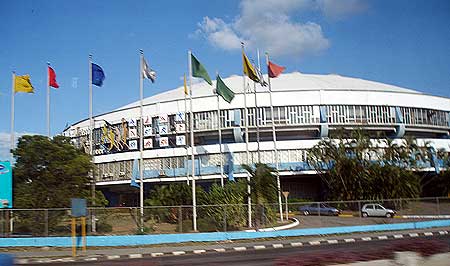Sports in Cuba: Another Achievement of the Revolution
Elio Delgado Legon

HAVANA TIMES — Before the January 1, 1959 triumph of the Cuban Revolution, sports in Cuba was limited to four professional baseball teams and a few outstanding individuals, who were always self-made individuals since the sports and recreation system of that time totally lacked governmental support.
In the pre-revolutionary era there was no sports infrastructure. Baseball was played almost exclusively in the capital. Nor did the country have sports schools. Participation in sports was limited to youth from wealthy families. In the private schools they attended were some facilities for engaging in sports, though almost never for serious competition.
When the revolution triumphed, physical culture and sports were recognized by the government as a right of the people and a way to promoting and maintaining good health. At that time, the building of the sports infrastructure began that would enable Cuba to develop its sports movement and achieve massive participation in sports across the country.
Over the past 54 years — despite being a poor country without major natural resources, (depending essentially on imported oil for its energy needs), despite its population having doubled, and being subjected to an economic, trade and financial blockade (whose avowed aim is to “create difficulties, hunger and disease so that the people themselves overthrow the government”) — Cuba’s sports infrastructure was developed. As a result, this has turned the country into a powerhouse in that realm.
It’s difficult to summarize in a short review everything that has been done in the country in terms of sports. Nevertheless, the outcomes speak for themselves. From the start of the Olympic Games in 1896 up until 1956 — a span of over 60 years — Cuba won only four Olympic gold medals.
However, starting from nothing, in its 54 years of revolution the island won 67 gold medals by 2012.
In all the Pan American Games in which Cuba has participated, it has always come in second place, behind the United States – except for the games held on the island (1991), where it came in first place, and in 1951 when it finished third. Prior to 1959 there were two Pan-American Games (in 1951 and 1955), in which Cuba won a total of 10 gold medals. After 1959, we’ve brought home 829 gold medals.
Cuba has developed a sports infrastructure throughout the country, including baseball stadiums in all provincial capitals and in some municipalities, many of them lighted for nighttime play.
A sports facility complex was built in Havana for holding the 1991 Pan American Games, one that includes facilities for all sports.
As for the system of school sports, this covers the entire country and culminates with the High Performance Athletes Training School, in Havana. However special mention is deserved by the Manuel Fajardo Higher Institute of Physical Culture, also in Havana, a university dedicated to sports and physical culture.
Sports Assistance Abroad
In the field of sports cooperation, Cuba currently provides technical assistance to more than 50 countries, to which it dedicates more than 8,000 teachers and coaches. As a result of this collaboration — to cite only one example — in the 2003 Pan American Games, Cuban coaches were involved with 71 teams from 17 countries. In the 2008 Olympics, the island had 18 collaborators (including coaches, physiotherapists and physicians) working with teams from 14 countries.
Hundreds of teachers, coaches and sports specialists from Third World countries have graduated in Cuba from sports schools or the institute mentioned above. Cuba also created the International School of Physical Education and Sports, which is attended by over 1,300 students from 71 countries.
In the field of sports medicine, Cuba cooperates with other Latin American countries, with these having access to the Institute of Sports Medicine. In addition, an anti-doping testing laboratory was built on the island, the fifth in the Americas, to provide services to developing countries in the fight against drug abuse, which is so damaging to sports and athletes.
In this brief summary I’ve tried to reflect what the Cuban Revolution has done in the field of sports, regarded as a right of the people, citing only the most salient issues – since several books could be written on this subject.
Here I’ve referred only to “muscular sports,” since I plan to discuss chess in a forthcoming post.

Moses Patterson, Cuba will always be Cuba no matter what your skewed views are
Thank you, Elio, for another excellent post.
Truly, one of the shrewdest political decisions Fidel ever made. The Roman poet Juvenal is credited with the saying ‘Give them bread and circuses and they will never revolt’. Having, at times, failed at the former, Fidel has indeed excelled at distracting the Cuban people with cultural diversions and sports. With most food prices rising and salaries frozen, bread in Cuba is even more important. If the flow of Venezuelan oil should stop, maybe even bread will become scarce. If so, sports will be all that is left.